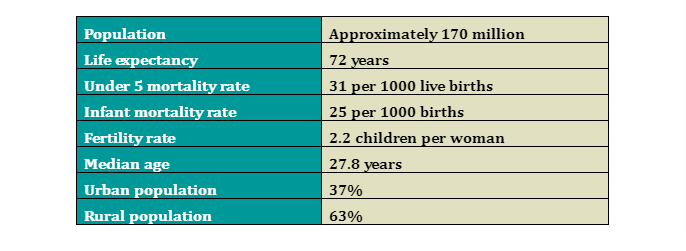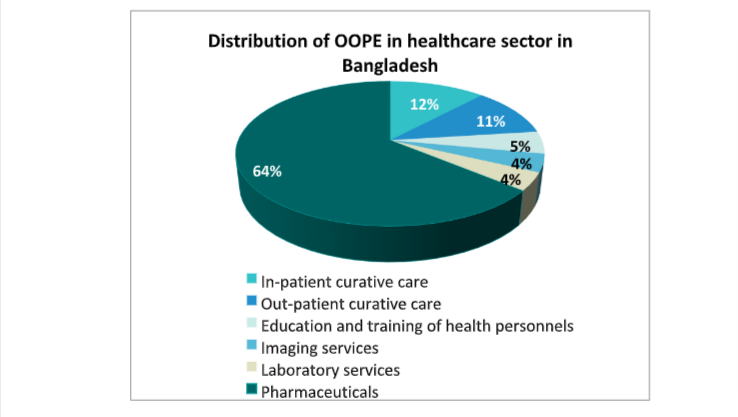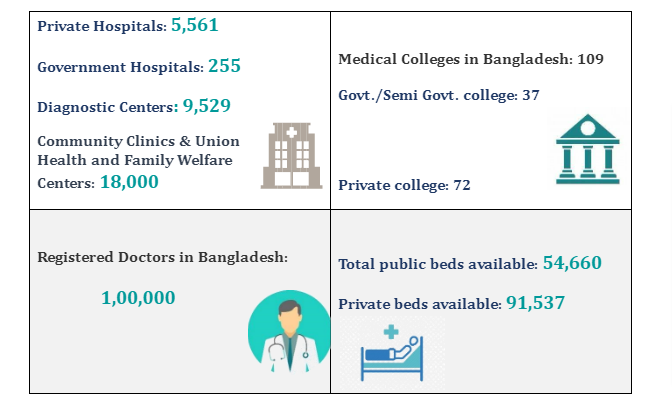Are you planning to build or restructure or venture in Bangladesh? Looking for information about the major healthcare players in Government and Private centers that are available in India? Are you looking to find out which part of the city is best to venture into or what all facilities are available and what should be planned for the new setup? In this article, Hospaccx Healthcare Consultancy has mapped all on major players in terms of the healthcare scenario of Bangladesh.
Below is a superficial and macro-level survey. If you need a refined market and financial feasibility or any other study related to healthcare, you can contact Hospaccx Healthcare business consulting Pvt. ltd at hospaccx.india@gmail.com Or you can visit our website on https://hospaccxconsulting.com/
Overview
In South Asia, Bangladesh is a heavily populated, low-lying, primarily riverine nation with a 720 km long coastline on the northern shore of the Bay of Bengal.
Bangladesh has made significant progress in the healthcare sector in recent years, but challenges still exist in ensuring adequate access and quality of healthcare for its population.
Access to healthcare remains a challenge, especially for people living in rural areas. Despite the government’s efforts to expand healthcare services in rural areas, there is still a significant shortage of healthcare providers and facilities, making it difficult for people to access the care they need. This is further compounded by the high cost of healthcare, which puts a significant financial burden on individuals and families.
The following table shows the demography of Bangladesh.

Healthcare Expenditure
Bangladesh has made strides in improving its healthcare sector by increasing its budget allocation for health. According to a recent report, the country’s health expenditure is expected to reach Rs 12,597 per person by 2026. This is a positive sign for the country’s healthcare system, which has long struggled with inadequate funding.
In the 2022-23 budget, the government of Bangladesh allocated 5.44% of the total budget for the health sector, which is a slight increase from the previous year’s allocation of 5.22%. This amounts to 0.83% of the country’s GDP, up from 0.81% in the previous fiscal year. The increased allocation demonstrates the government’s commitment to improving the healthcare infrastructure of the country.

The pie chart shows that pharmaceuticals represent 64% of OOPE in the healthcare sector in Bangladesh, followed by inpatient curative care at 12%, outpatient care at 11%, and education/training of health personnel at 5%. This indicates that medication and hospitalization costs are significant financial burdens for individuals seeking healthcare services in Bangladesh.
Healthcare Sector Composition


Major Hospitals in Bangladesh
Top 5 Government Hospitals in Bangladesh
- Bangabandhu Sheikh Mujib Medical University, Dhaka
It is a graduate medical university in Bangladesh. It was established in 1965. It has around 750 beds. It has an enviable reputation for providing high-quality postgraduate education in different specialties.
- Dhaka Medical College and Hospital, Dhaka
It is the oldest tertiary-level hospital located in the heart of Dhaka, Bangladesh. This hospital started its journey on 10 July 1946 as 200 bedded field hospital for the British Indian armed forces. Now it is 2600 bedded (300 bedded including Burn and Plastic Surgery Unit).
- Sheikh Hasina National Institute of Burn and Plastic Surgery, Dhaka
It is a hospital dedicated to burns and plastic surgery situated in Dhaka, Bangladesh. It is regarded as the largest burn and plastic surgical care center in the world. The institute has 500 beds, 22 ICU beds, and 22 HDU facilities. It has 12 operation theatres with a postoperative unit.
- Sheikh Russel National Gastroliver Institute & Hospital, Dhaka
It was established in 2018. It has around 250 beds along with 8 ICUs and 12 HDUs.
- National Institute of Cancer Hospital, Mohakhali
It was established in 1986. This is the only tertiary-level center in the country engaged in multidisciplinary cancer patient management. It has a 300-bed capacity.
Top 10 Private Hospitals in Bangladesh
- United Hospital, Dhaka
It was originally called Continental Hospital and was established in the mid-1980s.
and has around 850 bed capacity.
- Square Hospital, Dhaka
It is a tertiary care hospital and the leading contributor to private healthcare services in Bangladesh. It was established in 2006. It has a capacity of 500 beds.
- Evercare Hospital, Dhaka
It is a JCI-accredited 425-bed multidisciplinary super specialty tertiary care hospital in Dhaka, Bangladesh, and part of Evercare Group. It was established in 2005.
- Anowar Khan Modern Medical College Hospital, Dhaka
It was established in 2008. It has a capacity of 750 beds.
- Impulse Hospital, Dhaka
It was established in 2009. It has a capacity of 350 beds.
- Universal Medical College, Dhaka
Universal Medical College & Hospital Ltd. Former Aysha Memorial Specialised Hospital has been established in 1996 to serve the people by providing the best health care service as a private hospital in Bangladesh. It has a capacity of 250 beds.
- Samorita Hospital, Dhaka
It was established in 2010. This Hospital is a well-equipped hospital delivering both general and specialized services including ICU, Cath Lab, CT Scan, CCU, NICU, HDU & Dialysis unit.
- Ad-din Medical College Hospital, Dhaka
It was established in 2008. It has a capacity of 500 beds.
- Asgar Ali Hospital, Dhaka
It was established in 1972. It has a capacity of 250 beds.
- BRB Hospital, Dhaka
It was established in 2014. It has a capacity of 350 beds.
Insurance coverage
In Bangladesh, less than 1.0 percent of the population has a health coverage scheme that protects them against catastrophic health expenditures. In Bangladesh, approximately 3.8 percent of the total population, or 6.0 million people are pushed into poverty because of out-of-pocket payments for health services every year.
Challenges Faced in the healthcare sector
- Lack of innovative healthcare financing strategies
- Increasing the rate of the Out-of-Pocket Expenditure
- Low investment in Primary healthcare services
- Inadequate Funding: The healthcare sector in Bangladesh is underfunded, with only around 0.83% of GDP allocated for healthcare. This leads to a shortage of medical equipment, medications, and healthcare personnel.
- Shortage of Healthcare Workers: Bangladesh has a shortage of healthcare professionals, including doctors, nurses, and technicians. Many healthcare workers also migrate to other countries for better opportunities, exacerbating the shortage.
- Poor Infrastructure: Many healthcare facilities in Bangladesh lack adequate infrastructure and basic amenities, such as electricity and clean water. This affects the quality of care and the ability of healthcare workers to provide essential services.
Conclusion
Bangladesh’s healthcare sector has seen notable improvements in recent years with increased budget allocations and efforts to expand access to healthcare services. However, the sector still faces significant challenges, such as high out-of-pocket expenditures and inadequate healthcare infrastructure. Addressing these challenges and investing in healthcare is crucial to ensuring that all individuals in Bangladesh have access to quality healthcare services and achieve better health outcomes. With continued efforts and investments in the sector, Bangladesh can achieve its goal of universal healthcare coverage and ensure a healthier future for its people.
Above is the superficial and macro level study if you need a refined market and financial feasibility or any other study related to healthcare required you can contact us: Hospaccx healthcare business consulting Pvt. Ltd on hospaccx.india@gmail.com. Or you can visit our website on www.hospaccxconsulting.com
Related Team Members
Related Services
Other Industries
Related Blog
Related Success Stories










